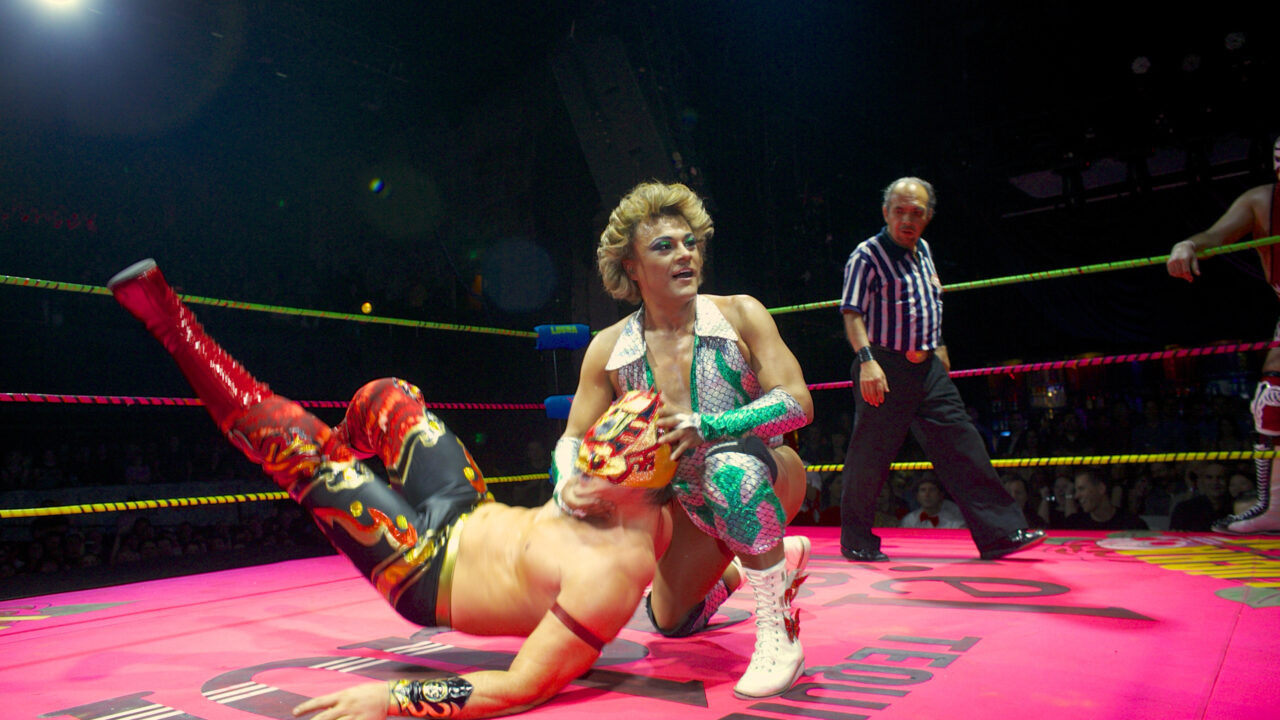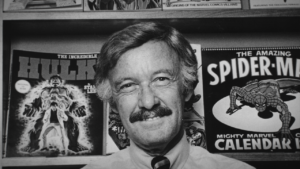Liberating Lucha Libre
A Sundance biopic bought by Amazon sanitizes a harrowing tale of real-world homophobia. Cassandro, the "Queen of the Ring" / AP photo by Damian Dovarganes
Cassandro, the "Queen of the Ring" / AP photo by Damian Dovarganes
Cassandro
Dir. By Roger Ross Williams
For outsiders to lucha libre and its American equivalents, Roger Ross Williams’ “Cassandro” weaves together the worlds of pro wrestling and drag. This overlap goes back nearly a century, from the frills of Nebraska-born Gorgeous George, to the shimmering silver capes of masked Mexican icon El Santo — and of course, to the exótico, a type of wrestling character that gained popularity (or rather, notoriety) in 1940s Mexico.
Exóticos’ overtly effeminate traits were intended to make them villains. In the 1980s and 90s, however, figures like Cassandro — dubbed “the Liberace of lucha libre” by fans — flipped the script and became transgressive icons. Williams’ film traces Saúl Armendáriz’s climb, and, with it, his use of drag as a form of in-ring heroism. In attempting to tell a focused story, “Cassandro” avoids the most intimate and thorny details of Armendáriz’s life, and rarely escapes the cliché trappings of most biopics.
Armendáriz’s reluctance stems from the fact that exóticos were scripted to lose — not to mention being villainized from the get-go.
This Hollywood formula was parodied in 2007 by “Walk Hard: The Dewey Cox Story” — a send-up of recent prestige biopics like “Ray” and “Walk The Line.” These tropes — such as the rise, fall and recovery structure that reduces people to their career trajectories — continue to be reproduced with uncanny accuracy by films like “Bohemian Rhapsody,” down to the brief and predictable drug-fueled escapades which threaten artists’ newfound stardom. “Cassandro” is no exception, and the many ways it contorts Armendáriz’s saga to retro-fit a well-worn formula have devastating consequences.
One has to imagine a level of awareness behind this decision. “Cassandro” is an American production, with American writers at the helm (Williams co-wrote the script with David Teague). The idea of making professional wrestling more palatable to an American audience — given its fall in U.S. popularity since the 1990s — is not entirely untoward. There is, after all, a significant stylistic overlap between lucha libre and its American counterparts, whose peak in mainstream acceptance 25 years ago coincided with (and was in some ways aided by) the import of luchadors like Rey Mysterio Jr. (an American-born wrestler whose uncle trained Cassandro) and their more high-flying, acrobatic style.
However, the movie’s visual framing of lucha libre ignores this athletic distinction from American wrestling. It ignores the Mexican industry’s (and Cassandro’s) high-speed theatrics, in favor of the more lumbering combat that first made wrestling a viable commodity in the U.S. in the 1980s, thanks to muscle-bound icons like Hulk Hogan.
The film is by no means without merit. Gael García Bernal plays Armendáriz with panache and vulnerability, from his early days as the scrawny masked villain El Topo (in real life, this character’s name was Mister Romano), to his attempts to break through the wrestling scene south of the border in Juárez.
This stylistic approach to the in-ring action (while by no means a death knell for the movie) indicates that the writing and directing are geared towards outsiders to Mexican wrestling, instead of accurately depicting the world in which Cassandro, the character, was born, and the world in which Armendáriz, the person, came of age. However, a more pressing concern — one which does active damage to the narrative — is that making the story palatable to such a wide cross-section of viewers requires fabrications that fly in the face of Armendáriz’s story. He was (and still remains) a performer known for breaking mainstream boundaries and refusing to confirm, while the movie often does the opposite, especially by re-shuffling the particulars of his story as a queer man struggling against a hyper-masculine industry.
The film is by no means without merit. Gael García Bernal plays Armendáriz with panache and vulnerability, from his early days as the scrawny masked villain El Topo (in real life, this character’s name was Mister Romano), to his attempts to break through the wrestling scene south of the border in Juárez. We see his life at home in Texas with his doting mother (Perla De La Rosa) who readily accepts his homosexuality. Tired of losing as El Topo, he seeks the help of an experienced fighter, the fictitious Sabrina (Roberta Colindrez), who becomes his confidante but urges him to take on the role of an exótico in order to stand out.

Armendáriz’s reluctance stems from the fact that exóticos were scripted to lose — not to mention being villainized from the get-go. In American wrestling parlance, they were perpetual “heels,” denied the option of ever winning over the audience— but the movie frames the subversion of these deep-seated wrestling tropes (meant to feed the crowd’s homophobia) as only a minor hurdle, which he quickly overcomes.
To illustrate Armendáriz’s ascension to the wrestling big leagues, the script collapses several years of his career into mere minutes on screen. Before long, he develops a drug habit, courtesy of a dealer played by Puerto Rican rapper (and occasional WWE wrestler) Bad Bunny, whose acting is surprisingly understated. A torrid affair ensues, with closeted family man and fellow wrestler Gerardo (Raúl Castillo). The film also drops a few hints about the origins of Armendáriz’s love for the sport: he and his now-estranged father once watched wrestling together. Although his father’s absence looms large over the entire plot through recurring flashbacks, which explain his initial interest in lucha libre, it’s more of a background detail in the present, which frequently re-appears as an extension of his mother’s continued longing, rather than a facet of Armendáriz’s own psychology.
A major problem with “Cassandro” is that although it unfolds at the nexus of two performative worlds — wrestling, with its boisterous characters under the spotlight, and queerness itself, as something Armendáriz must stealthily navigate within the lucha libre world — it presents neither one as performance itself, but rather as professional happenstance, the way one might think of a desk job in an office cubicle. Apart from a scene in which Armendáriz raids his mother’s closet to craft his costumes for the ring, there’s little sense of the way his character — from his fighting style, to the effeminate provocations he directs at the crowd — is informed by his sexuality, his paternal struggles, or really, any aspect of his personality. The film simply does not approach wrestling the way Armendáriz did: as an art form.
The result lacks the subversive gentleness (and communion through outsidership) of his real-life inspiration: a Tijuana prostitute-turned-brothel owner named Cassandra, whom Armendáriz admired for her overt sexuality and charitable grace.
There are scant moments when the camera enters the ring. Only a handful of shots capture the momentum of the performers’ actions (García Bernal does manage a few complicated flips and maneuvers without the aid of a stunt double). For the most part, any aestheticization of lucha libre is distant — the movie’s bright lights cast a dull wash rather than a dazzling spotlight — thus failing to illustrate why both fans and performers are drawn to the form in the first place. In spinning its own version of Armendáriz’s life, “Cassandro” excises the elements of his backstory perhaps deemed less palatable for a mainstream audience, including the origins of his drag-adjacent persona. No film ought to be beholden to real life, but there is a cascading effect to the script’s numerous departures.
For instance, the movie frames Armendáriz’s choice of stage name as having been inspired by the Venezuelan telenovela “Kassandra,” which is fitting for a story about a character who hopes to assimilate into an existing version of mainstream stardom. However, the result lacks the subversive gentleness (and communion through outsidership) of his real-life inspiration: a Tijuana prostitute-turned-brothel owner named Cassandra, whom Armendáriz admired for her overt sexuality and charitable grace.
The film reduces the homophobia Armendáriz faced to a few scattered chants in the crowd during his earlier matches, before sanding down the roughest edges of his experience as a queer performer in an industry that has traditionally rejected queerness.
Another noteworthy departure is the movie’s drug-fueled pitstop prior to Armendáriz’s big breakout, a high-profile exhibition match with El Hijo del Santo (the son of the late aforementioned icon, El Santo). In “Cassandro,” the hurdle he must cross en route to this landmark is his own vice — a familiar narrative turn of prestige biopics — but the real story was much more harrowing. In the process of mapping Armendáriz’s narrative onto expected tropes, it sanitizes the overwhelmingly homophobic backlash that the match provoked. This reaction led Armendáriz to attempt suicide in real life (not to mention the fact that — according to his profile in The New Yorker, which also details some of the ugliest homophobia he faced — he was found and rescued by his lifelong friend, fellow exótico Pimpinela Escarlata, who has also been entirely erased from the movie).

The film reduces the homophobia Armendáriz faced to a few scattered chants in the crowd during his earlier matches, before sanding down the roughest edges of his experience as a queer performer in an industry that has traditionally rejected queerness. Wrestling has changed in the intervening years (for instance, contemporary queer champions like AEW’s Anthony Bowens). Cassandro has little perspective on just how monumental this shift actually was during Armendáriz’s heyday, and how much of an influence he had on liberating lucha libre from its own narrow norms.
The movie’s version of reality is at once glamorized and un-glamorous: pristine on the surface but empty underneath. “Cassandro” shows us a spotless image that lacks the visceral thrills of wrestling and the seductive allure (and sheer, unrestrained fun) of drag performance. Most unfortunate of all, it reduces queerness to a brief plot point. A mere passing detail, tacked on with an occasional hushed comment, rather than something Armendáriz experiences in life, both in and outside the ring.
Your support matters…Independent journalism is under threat and overshadowed by heavily funded mainstream media.
You can help level the playing field. Become a member.
Your tax-deductible contribution keeps us digging beneath the headlines to give you thought-provoking, investigative reporting and analysis that unearths what's really happening- without compromise.
Give today to support our courageous, independent journalists.






You need to be a supporter to comment.
There are currently no responses to this article.
Be the first to respond.